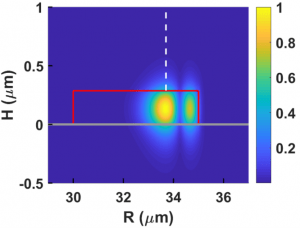Quantum entanglement is a fascinating phenomenon with no analog in classical physics. If two particles are entangled, then a measurement on one particle will instantaneously affect the other particle’s state, even if they are separated many light-years away. The counterintuitive nonlocality was first questioned by Einstein, Podolsky, and Rosen (EPR) and probably also by every classical mind. Amazingly, however, this “spooky action at a distance” has been verified by experiments that violated Bell’s inequality.
Today, quantum entanglement has become the foundation for many quantum information and sensing technologies. To efficiently generate entanglement between atoms and photons and to implement quantum networks in a scalable manner, we need strong interactions between single atoms and single photons such as is readily available cavity Quantum Electrodynamics [1].
A promising approach to scalable cavity QED on-chip utilizes SiN micro-resonators combined with miniature, chip-scale atomic beams pioneered by our group [2, 3]. The pictures above show the proposed platform (left) and the electric field profile (right) of a high-Q micro-resonator fabricated in collaboration with Ali Adibi’s group in the Georiga Tech School of Electrical and Computer Engineering [4]. A collimated beam of atoms passes above the resonator and each atom strongly interacts with the cavity photon through the evanescent field. Through numerical simulations we have shown that slow atomic beams with a longitudinal speed of 0.2 m/s to 30 m/s will interact strongly with our resonator, allowing for the detection of single-atom transits and realization of scalable single-atom photonic devices. In the future, it may also be possible to utilize thermal atomic beams to achieve strong coupling of single atoms and photons.
References:
[1] A. Reiserer and G. Rempe, “Cavity-based quantum networks with single atoms and optical photons,” Rev. Mod. Phys., vol. 87, no. 4, pp. 1379–1418, 2015.
[2] Li, C., Chai, X., Wei, B., Yang, J., Daruwalla, A., Ayazi, F., & Raman, C. (2019). Cascaded collimator for atomic beams traveling in planar silicon devices. Nature communications, 10(1), 1-8.
[3] Li, C., Wei, B., Chai, X., Yang, J., Daruwalla, A., Ayazi, F., & Raman, C. (2020). Robust characterization of microfabricated atomic beams on a six-month time scale. Physical Review Research, 2(2), 023239.
[4] Dorche, A. E., Wei, B., Raman, C., & Adibi, A. (2020). High-quality-factor microring resonator for strong atom–light interactions using miniature atomic beams. Optics Letters, 45(21), 5958-5961.


